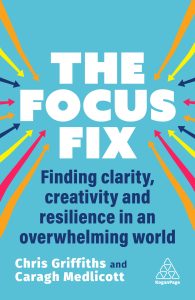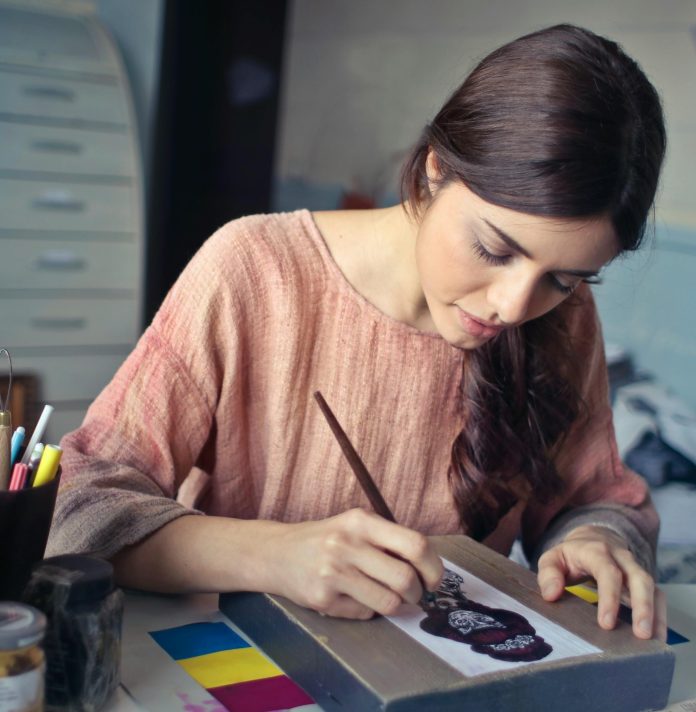By Chris Griffiths and Caragh Medlicott, below, authors of The Focus Fix
 If we asked you to name a creative person, chances are you’d
If we asked you to name a creative person, chances are you’d  pick someone well-known. An artist, perhaps – or an inventor. Because of the clear correlation between creativity and success, we tend to bestow a type of prestige on creative ability. This isn’t, in and of itself, a bad thing. It’s certainly true that creativity is a coveted and beneficial skill, but we should be wary of thinking of it solely as a rare and unique talent bestowed on a lucky few. Contrary to common perception, every single one of us has the ability to be creative. What holds us back is not our skill, but the limiting beliefs and biases we learn through the process of our education and entrance into the world of work. The good news, however, is that by implementing some practical steps you can actually enhance your creativity, and reap all the associated benefits. To do so, you simply need to change your mindset and make the most of naturally-occurring neurological tools in order to usher in more innovative thinking.
pick someone well-known. An artist, perhaps – or an inventor. Because of the clear correlation between creativity and success, we tend to bestow a type of prestige on creative ability. This isn’t, in and of itself, a bad thing. It’s certainly true that creativity is a coveted and beneficial skill, but we should be wary of thinking of it solely as a rare and unique talent bestowed on a lucky few. Contrary to common perception, every single one of us has the ability to be creative. What holds us back is not our skill, but the limiting beliefs and biases we learn through the process of our education and entrance into the world of work. The good news, however, is that by implementing some practical steps you can actually enhance your creativity, and reap all the associated benefits. To do so, you simply need to change your mindset and make the most of naturally-occurring neurological tools in order to usher in more innovative thinking.
Change your mindset
If you’re feeling sceptical about your ability to be creative, then this is your first barrier to actually achieving it. Of course, no one can blame you for feeling uncertain – in the wider culture we often see a narrow picture of creativity depicted. Whether it’s bohemian musicians or eccentric entrepreneurs, when we’re faced with the incredible and unique feats of some of the world’s most talented individuals, we naturally feel insufficient by comparison.
But the good news is that research shows that there is no definitive link between creativity and DNA. In other words, while there are a few genetic components that may increase the likelihood of you being creative (due to the neurological ability to make connections) – they do nothing to guarantee it. What’s more, there is plenty of other evidence to suggest that a number of external factors and tools can be employed to improve creative ability. So changing your mindset to reframe your own creative potential is the first key step to fulfilling it. Open yourself up to all that you might achieve!
Unlearn biases
At what point in your life did you feel most creative? For many people, the answer is in childhood. As kids, imagination comes to us easily. In fact, there’s good reason to think that all of us are born creative – but we slowly unlearn this as we age and become accustomed to certain cultural norms and frameworks which can actually quash our inherent ability.
This idea was substantiated by one landmark study in 1969. It found that creativity, which seems innate in children, significantly declines with age. Of 1,600 five-year-olds tested, 98% were highly creative, but by age 10, only 30% maintained this level of creativity, and by age 15, it dropped to 12%. Of 250,000 adults over 25, only 2% scored in the highly creative bracket. What this ultimately means is that you can relearn your inherent creativity by unlearning the constructs and biases that have blocked this ability during the process of ageing.
There are, in fact, three key thinking traps people frequently fall into that can stifle creativity. The first is reactive thinking – this involves making decisions quickly, often relying on instinct and past experiences, which can lead to overlooking more viable alternatives. A more deliberate consideration of various options can help when it comes to generating ideas, so watch out for this particular thinking trap next time you get creative.
The second is selective thinking. This occurs when individuals give undue weight to information that aligns with their pre-existing beliefs, while disregarding contradictory evidence. Recognising and mitigating this bias by actively seeking diverse perspectives is essential for adopting a broad, open-minded type of creativity.
The third and last trap is assumptive thinking. This is when decision-making is constrained by an over-reliance on outdated assumptions. By critically evaluating your assumptions with current, evidence-based insights, organisations can open up new possibilities for creative success.
When we start to address these thinking traps, we naturally open ourselves up to a more innovative perspective. Naturally, idea-generation and implementation is a key cornerstone of being creative. While you might think that you’re short on ideas, the reality is that you might just be blocking your potential through your biases and assumptions. By unpicking these knots you can restore your child-like sense of imagination.
Start to daydream
You may not know it, but daydreaming is in fact one of the most powerful creative tools in your neurological arsenal. Generally, we tend to think of mind wandering as something we do by accident – and certainly not something we benefit from. But I’m here to tell you that you may need to reconsider this viewpoint as there’s a wealth of evidence connecting daydreaming to creative ability.
In fact, it seems that – far from going dormant during mind wandering sessions – our brain is more connected than usual. This is why researchers have concluded there’s such a clear correlation between the act of mind wandering and a person’s ability to generate quality ideas or solve problems.
So, what does this mean for boosting creativity? In essence, that you can make yourself more creative by making time to daydream more. Given there is also a link between regular breaks and improved work – you can experience the benefits of both a sense of wellbeing and an increased propensity for creative thinking.
However, it’s important to note that to get the best out of this, you need to bring intention into the process. You can do this by time-boxing your daydream sessions so they don’t run over (think no longer than half an hour), and consider giving your imagination fuel prior to these sessions (whether that be in the form of research, a mood board, or simply looking through your next upcoming project). That way, you can give your daydreaming sessions direction and generate ideas that are beneficial to you.
In conclusion
Creativity is not an exclusive trait reserved for a lucky few—it’s an ability that we all have the power to enhance. By shifting your perspective, breaking free from ingrained biases, and intentionally using daydreaming as a creative tool, you can tap into a wellspring of innovative thinking. Creativity flourishes when we step outside conventional boundaries, stay open to new ideas, and allow our minds the space to explore. Begin today by embracing these strategies, and you’ll likely discover that your creative potential is far greater than you ever imagined.
 Chris Griffiths and Caragh Medlicott are the authors of The Focus Fix: Finding clarity, creativity and resilience in an overwhelming world
Chris Griffiths and Caragh Medlicott are the authors of The Focus Fix: Finding clarity, creativity and resilience in an overwhelming world


